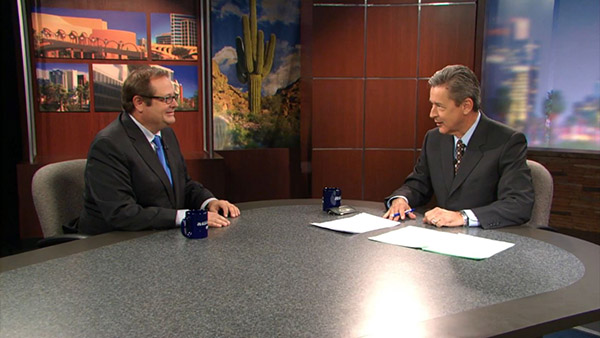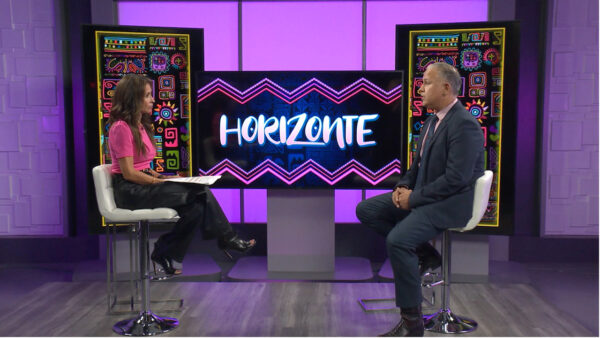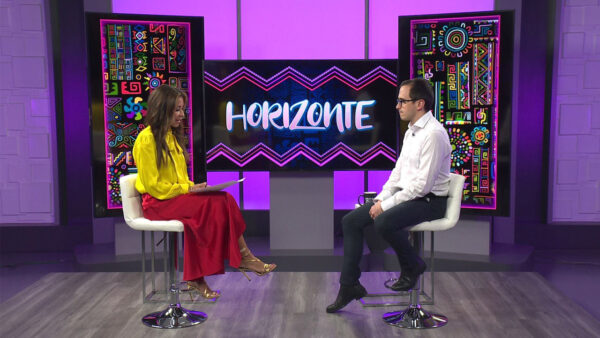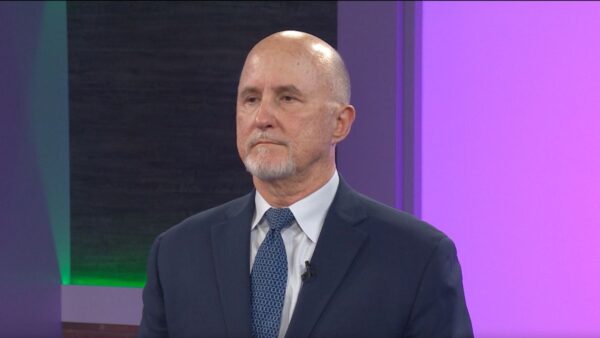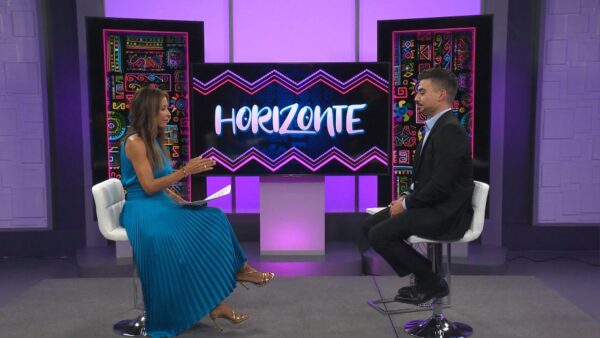According to the Maricopa County Health Department, so far this year 23% of new cases of HIV/AIDS are Latino. Maclovia Zepeda Director of HIV/AIDS Services for LUCES (Latina Unidos Contra El SIDA) and Rosie Casillas, Chicanos Por La Causa’s Program Coordinator for LUCES program, talk to Jose Cardenas about HIV/AIDS in the Latino community.
Jose Cardenas:
Good evening. I'm Jose Cardenas. Welcome to Horizonte. The impact of aids among Latinos. We'll talk to a national coalition dedicated to this issue and a resource in the valley for aids. Also an exhibit displaying the tradition of handmade grave marker memorials in the southwest. Hear from the photographer who captured these images and a local filmmaker takes the issue of illegal immigration and illegal border crossing and puts it into a documentary. That's next on Horizonte.
Announcer:
Funding is provided by SRP .
Announcer:
SRP 's business is water and power but our dedication to the community doesn't stop there. SRP, delivering more than power.
Jose Cardenas:
According to the Henry J Keiser family foundation, Latinos in the United States continue to be affected by the HIV-aids epidemic. Accounting for a greater proportion of aids cases than their representation in the US population overall and second highest by race and ethnicity. Latinos are underrepresented in Arizona by the number of aids cases. Recently I had to talk about this issue with Maclovia Zepeda. Zepeda, director of HIV/aids services for Luces, for Latina unidos contra el sida and with Rosie Casillas program coordinator for the Luces program for chicanos por la causa.
Jose Cardenas:
Rosie, welcome to Horizonte. Rosie, you've been involved in this program for quite some time. Tell us about your background and what you've been doing.
Rosie Casillas:
I first began with Maricopa county public health in receptionist work, then counseling and testing and CDI which is communicable disease investigations. Then I went on to be a case manager. I was actually searching for every aspect of HIV for the clients. Went on to be a counselor full-time and programmed the first study for hepatitis C for the state and study -- and started the first support group in 1996.
Jose Cardenas:
Support group for Latinos.
Rosie Casillas:
Yes. Because I saw the need for information in Spanish, for more Spanish-speaking personnel so I began that in 1996 at a place called the Malta Center which has now moved on to Las Vegas. And then I took my program -- tried to take my program wherever as a support group. And finally CPLC said yeah, we'll take it on. And I've been there since.
Jose Cardenas:
And Maclovia Zepeda:, when Rosie Casillas brought the program for Chicanos por la causa to CPLC, what was the response from the organization?
Maclovia Zepeda::
It was the only organization at the time that actually stepped up to the plate in terms of wanting to take the challenge of housing this program there at one of their sites. It was something that was needed within the community. And no one really wanted to address the issues of HIV and Latinos except for CPLC at that time.
Jose Cardenas:
And CPLC came up with the program that's now called Luces, is that correct?
Maclovia Zepeda::
Correct.
Jose Cardenas:
What does that stand for and what are the components of it?
Maclovia Zepeda::
Latinos Unidos Contra El Sida, which is Latinos United Against Aids.
Jose Cardenas:
Sida being the Spanish words for aids?
Maclovia Zepeda::
Correct.
Maclovia Zepeda::
We have the components of the program one being mental health services, the other being substance abuse services and treatment. The other is outreach, targeted outreach to the Latino community. Now, our behavior health and substance abuse services are both outpatient. Under the behavior health we have a weekly support group that takes place at one of our sites. And it's for individuals, Spanish-speaking individuals who are HIV positive.
Jose Cardenas:
And what's the scope of the problem that we're dealing with right now?
Maclovia Zepeda::
What it is, there are a number of factors that contribute to this problem. One being lack of education, lacking to educate the Latino community in terms of HIV infection.
Jose Cardenas:
Well, and the public in general, too. Because as I understand it, the sense is that aids while still a terrible, terrible disease and we've got a long ways to go in dealing with it is under control. But that's not really the case with the minority population, is that right?
Maclovia Zepeda::
Not at all. We talked about in my field I talk about statistics all the time. And being that Latinos are -- represent about 30% of the population in Maricopa county we represent about 23% of the new cases of HIV in Maricopa county. There was some new statistics that came out through the county that from January of '06 to June they had about 90 individuals who were tested positive. And of those 90, 50% of them are Latinos.
Jose Cardenas:
And Rosie, what explains that? Why the increase in incidence of aids among the Latino population as compared to the overall aids population which seems to be holding steady?
Rosie Casillas:
I think what happens there is the word "aids" in Spanish, "Sida" whenever they see a pamphlet or an announcement or anything relating to HIV they say aids. A lot of people say, "we're here for an aids test." if you're HIV positive that doesn't mean you've got aids. It's a long, in between period if you're not taking care of yourself. A lot of times, too, the women don't test for the fact that they're so afraid to come out positive and then how do they explain back to their husband even though it may be the husband that's passing on the infection to them. And so there's a lot of myths also that HIV is strictly for gay males or that in the case that you're even wanting a test that you're doing drugs. That's just not the truth. People in any class or any race, anyone should come in and test. Because this is a growing disease.
Jose Cardenas:
Now, we've talked before -- we were talking before we came on the program about the need and appropriateness of culturally appropriate outreach. What do you mean by that and why would that be important to the Latino community?
Rosie Casillas:
Because it's very important when you have somebody speaking to you of your own language and own ethnicity telling you or giving you information on a certain subject you feel more comfortable, you're more apt to retain the information that they're giving you. And we open the doors for testing for them and let them know that it's very necessary to test because we really need to get this epidemic down. And if we have the proper tools to do it in the state of Arizona , especially in Phoenix , then we really need to work hard at doing it.
Jose Cardenas:
Maclovia Zepeda: going back to some of the statistics that are rather startling in terms of the percentage of untreated HIV positive patients in the Hispanic population, how does that compare to the national population?
Maclovia Zepeda::
Well, Arizona has a huge unmet need rate. The Arizona department of health services published I would say a survey that was conducted in 2004 that estimated about 40% of the population, where -- not the total population but we have a 40% of unmet need rate. Which basically means we have a lot of -- we have like over 2,000 plus individuals who are living with HIV, know that they're HIV and not getting treatment.
Jose Cardenas:
And that compairs with I understand it a 20% unmet need rate nationally?
Maclovia Zepeda::
Correct. Nationally the rate is about 20%, which is half of what we are in the state of Arizona .
Jose Cardenas:
And what kind of resources is the state and the county devoting to this problem?
Maclovia Zepeda::
Well, they're working in conjunction with federal officials, CDC officials, in terms of creating and developing new outreach strategies in order to get to these high-risk populations and actually link them into services.
Jose Cardenas:
But as I understand, Luces is one of the only programs like it that's being employed right now, right?
Maclovia Zepeda::
Under Ryan White we are the only agency receiving moneys for targeted outreach to the Hispanic community.
Jose Cardenas:
And Ryan White refers to the federal funding program.
Maclovia Zepeda::
Correct. Title one, yes.
Jose Cardenas:
Rosie, there are a number of activities going on. One that's coming up will be the national Latino aids awareness day. Tell us about that.
Rosie Casillas:
That's a national event. And we're really looking forward to having it. It's a national event to help everybody become aware of the state of being that we're in the United States and how many more people are becoming infected every day. And so we want to recognize the importance of being tested for HIV and for people not to be afraid to come and test and that especially because it's a free test you get your results right away. So we want to recognize every agency, every program that's assisting with HIV information or testing or in any aspect. And this is like I said again it's a national event.
Jose Cardenas:
Maclovia Zepeda:, last question for you. What's the most important thing your group is trying to communicate to the population at large?
Maclovia Zepeda::
We're trying to deliver the message in terms of testing, that to get tested if you feel you're at risk, to get tested and that there are services available. It's no longer a death sentence. And there are agencies like Chicanos for la causa who dedicates their programs to helping serve people living with the virus.
Jose Cardenas:
Maclovia Zepeda: Sepeda, Rosie Casillas of chicanos por la causa, thank you for joining us.
Jose Cardenas:
The Southwest culture has changed over time. A local exhibit focuses on one of those traditions, the handmade grave marker as art and the time-honored tradition behind them. Let's take a look at some of those images. ¶¶[music]¶¶
Jose Cardenas:
Joining us to talk about this exhibit is the photographer behind the art, Dick George. Dick, those are very moving pictures. I understand that competition covers actually -- exhibition covers graveyards from all over the southwest but the images are from my understanding from Arizona , is that right?
Dick George:
Most of them are. Not all of them. The exhibit spans work that I made in southern Colorado , New Mexico , Arizona and west Texas .
Jose Cardenas:
But the images we had on the screen just now were I understand principally from Arizona .
Dick George:
Seem to be, yeah.
Jose Cardenas:
Before we talk more about the exhibit itself, tell us more about your background especially your work in photography.
Dick George:
Well, I worked for a long time as the producer of a magazine, membership magazine for the Phoenix Zoo. And then about the time that I was ready to move on to other things, I discovered the custom of the handmade grave marker almost by accident.
Jose Cardenas:
As I understand it's a very fascinating story. Why don't you tell us about it.
Dick George:
My wife and I were on a deliberately agenda-free vacation. And the very morning we happened to be in Farmington , New Mexico . And on the way out of town I noticed the local cemetery which is very neat, orderly, green, well-manicured. And every marker is seemingly the same height, same color. Very precisely lined up. Except as I was walking along I saw a straw hat propped up on one marker. It was a woman's straw hat, the sort of thing that she would wear while she were hiking or gardening or something like that. And I got to thinking about that. Why would somebody leave a hat on a grave stone. I had not noticed anything like that. I may have seen it sort of thing but I did not -- I did not really notice it until that day. I got to thinking, what other things do people do to personalize the graves of people that they've lost. And my wife and I got to talk about it as we were leaving town. And she came up with a suggestion, well, why don't we look for more of these things? So we did. And I'm a little uneasy confessing this in public. It's probably something I should bring up with a counselor. But in the next 10-days we visited 27 rural graveyards and had a wonderful time.
Jose Cardenas:
It is definitely not your typical vacation. But it led to this marvelous collection.
Dick George:
Yes.
Jose Cardenas:
As I understand the focus is on the 20th century. Why is that?
Dick George:
Well, for one thing there aren't many handmade grave markers in traditional cemeteries in the southwest that predate that time. The renaissance, if you will, of the cemeteries and these grave markers really is the 20th century.
Jose Cardenas:
And we talk about a change in the southwest culture. How would you define first of all that southwest culture in terms of it's as I understand it's rural in origin and predominantly Hispanic?
Dick George:
It is largely but not exclusively Hispanic. It is exclusively rural. These are people who lived on these parcels of land for a long time. Sometimes four or five generations, even longer. They lived subsistance farming lives. And when they lost someone, they often didn't have the money to go out and buy a commercially-made marker. So they had to resort to a very deliberate and artful form of recycling. They went out behind the barn. They got the used, broken-down tractor. They got the old bathtub.
Jose Cardenas:
And they got the old wheel barrow in one of the images there. Let's talk about some of the specifics beginning with that one.
Dick George:
That one is in central Arizona . And I found it about a week after it was put in place. It has the lady's name and her dates. And here was an inexpensive gardening wheel barrow from a discount store. Somebody had painted the information on the side. And they'd filled it with dirt and plastic flowers. And again, a gardening hat. Somebody knew her very well and knew her loves in life.
Jose Cardenas:
So I understand there were three principal themes in the exhibition, tell us about that.
Dick George:
The first one I call a sense of place because the traditional grave marker is so out of the range of experience of most urban people in the southwest these days. When I tried to talk about what a traditional cemetery was, most people don't know. And so I devoted a third of the show to photographs that show the place, show dozens or hundreds of grave markers in a single location. The second section of the show is called variations on a theme. And the theme is the form of a cross. But it's in an unbelievable array of materials and sizes and shapes. There was one photograph that you showed where somebody had taken their hands the day of the burial and had carved out in the dust of the desert the shape of a cross.
Jose Cardenas:
I understand that third area was private symbols. We've got about roughly 30 seconds left. Tell me which one was your favorite and why.
Dick George:
Very hard to say because they're all my children, of course. A lot of people react to the dug out cross. Another one is called storm clouds. I was fortunate to be leaving a cemetery when a storm was breaking and I got this very spectacular display of clouds right behind a cast iron "cerakita", the decorative fence.
Jose Cardenas:
Dick George thank you for sharing your time with us today and those images in the exhibition.
Dick George:
You're quite welcome.
Jose Cardenas:
Descanse en paz is at the Mesa museum until September 17 th.
Jose Cardenas:
Illegal immigration has been a controversial issue in our state and across the nation. We've all seen images on the news of undocumented immigrants crossing the border. A recently released documentary gives an inside account of illegal border crossings from a resident's perspective. The film has been called controversial and realistic. Nadine Arroyo talked with the producer, writer and director of the film Mercedes Maharas. We must warn you the video you are about to watch may contain some graphic images that may be disturbing to some viewers. Viewer discretion is advised. ¶¶[music]¶¶
Nadine Arroyo:
Immigrants and immigration are the talk of the nation. It consumes much of our politics. But for the first time a resident who experiences illegal border crossings speaks out through film. Mercedes Maharas is a resident of Cochise county located in the Southeast region of Arizona and the creator of a recently-released film which dissects the issue of immigration on the border.
Mercedes Maharas:
I felt I had a social responsibility to try to speak out, to try to inform others about our traumas and tragedies of life and death of living on the border. I have taken my trauma and the tragedies that I have felt very deeply because I'm a humanist at heart. I love people. And I love life. And I want a better life for all of us. And so I think it's impacted me in that I could put all the hurt that I was feeling into something positive and give it back.
Man 1:
A lot of it is coming through Mexico through the big semi trucks? Why? Our policy on free trade deal. Customs have been told, don't hold up the trucks. Keep them moving. They call it line release. In other words, they got to keep them just going through. So how in the hell can we check them for drugs if they tell us don't hold them up?
Nadine Arroyo:
Maharas is a retired teacher. A human rights activist and a producer among other things. She a left leaning film maker, along with coinservative executive producers created a bipartisan piece depicting the issue of illegal border crossers. The documentary provides a candid look into the complicated issue of immigration from talking to residents and border authorities to dissecting the humanitarian issue and even candid footage of illegal immigrants literally crossing the border and dead in the desert.
Mercedes Maharas:
I felt that my neighbors had become complacent. And it was just so shocking to me. I'm saying, wait a minute. What's going on here? This is not normal. And I had the background and experience to be able to communicate about it. And I just couldn't sleep at night. I said, I have to say something. I have to try to make a difference. I mean, it's just me, an old woman now. But I can still try to make a difference. ¶ Mr. And Mrs. Alien walk gently through our lands. This is our home our sacred place-- [inaudible] --we're sick and tired of hauling your trash, paying your medical bills ¶
Mercedes Maharas:
I wanted to inform others who know nothing about life and death on the border. Anyone who has an interest in the border I believe on the DVD will come away enhanced. I'm not saying it's going to be a pleasant experience to view it. Because it's really not. There are so many issues and so many different voices and there seems to be a lot of banging of heads and a very human way. We're very troubled by the violence and the death that is occurring which we feel like would be needless if our federal representatives were very serious and devoted a lot of time to solving this and solving it properly.
Man Singer:
¶ don't bring disease or drugs or guns ¶ ¶ you better be kind and nice ¶
Man 2:
I would say it's about as close about 98% that are Mexican nationals.
Man 3:
Yes. I believe there's a threat. Regarding other illegal immigrants of other nations.
Mercedes Maharas:
I'm a little prejudiced. I think it deserves our total attention at the moment so that we're not losing any more lives and that we're able to establish order and give dignity to immigrants who wish to pass into the United States so they can come here with documents and have their heads held high. And at the same time, to create respect for the border residents. Politics in the dictionary says that it's the art and science of government. That was stunning, a stunning definition. So I'm having a little difficult time right now trying to integrate what that means exactly. Where is the art of government and where is the science of government? If it makes up politics, I think that one and one are not making two here. Otherwise we wouldn't be having the trauma that we have and the difficulties of managing life. On the border.
Jose Cardenas:
If you would like to see a transcript of tonight's show or get information about upcoming topics please visit our website at azpbs.org. Once you get to our home page click on Horizonte for more details. That's our show for tonight. We hope you'll join us next Thursday. I'm Jose Cardenas. From all of us here at Horizonte, have a good evening.
Announcer:
If you| have questions or comments about Horizonte, please write to the addresses on your screen. Your comments may be used on a future edition of Horizonte.
Maclovia Zepeda: Director, HIV/AIDS services, Luces, for Latina unidos contra el sida;
